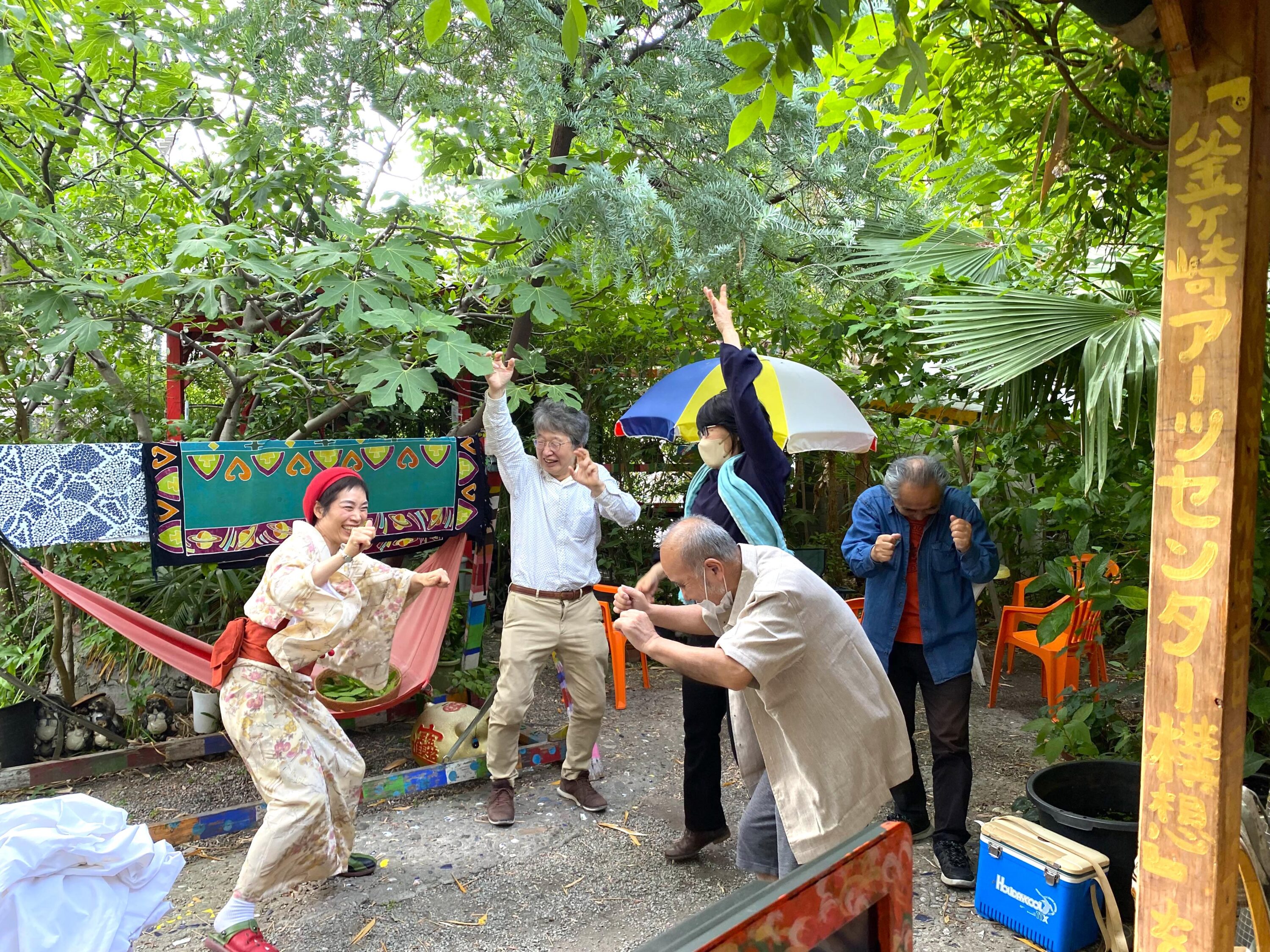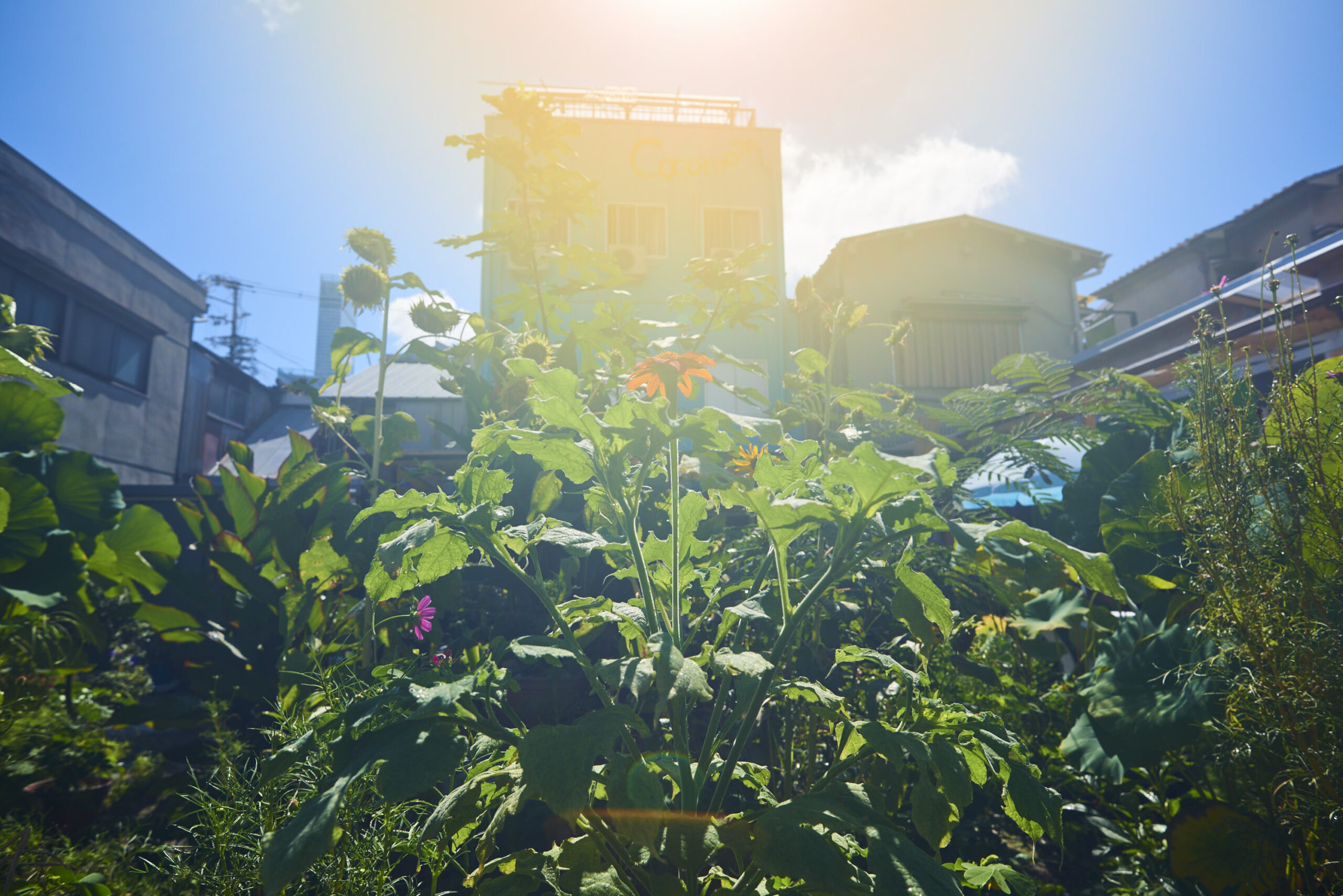[Article] Clinging to This Community: Kanayo Ueda
2025.9.10 (Wed)
The festival’s key phrase for 2025 is “nameless leaf clings to the matsutake mushroom.”
Inspired by Matsuo Basho’s metaphorical haiku and expanding our ideas, the festival aims to think about our encounters and co-existence with the unknown and the unfamiliar, as well as to consider the possibilities that spread from such thoughts. In conjunction with this, we asked three writers to contribute articles about this key phrase. We hope these writings will spark your interest and act as alternative doors for experiencing the festival.
Though all look so troubled, clinging to lives led day to day, there’s something funny about it all. What tomorrow will bring, none know a jot, but things will work out somehow. Don’t you think so too? For this is Kamagasaki, Osaka.
Kamagasaki? Airin? Nishinari? In any case, a frown descends whenever someone hears the name of this area. No, I don’t go there. Well, I could go, but don’t want to get too involved. Such are the words that are exchanged.
My first experience with Kamagasaki was one morning in May 1990. I was there for May Day, having come on the basis of a casual invitation. I participated in a protest at Sankaku Park and was surrounded by riot police. I got jostled. Men stood in a daze by the side of the road, faces devoid of expression. The red flag made a lasting impression.
I never went back until 2003, when I was invited to join the Osaka City Contemporary Art Base Formation Project, a public-private venture, and launched the art nonprofit Cocoroom in Shinsekai, Naniwa Ward, on a site a mere twenty meters from Kamagasaki. The Osakans told me, “Think of the homeless as stones.” There seemed to be a transparent wall enclosing the section of the city’s railway loop line between Naniwa and Nishinari wards.
And what of art?
Have you ever thought about the relationship between art and poverty? I don’t mean about artists being poor, but the relationship between art and people living in poverty. It is often said that it’s good for children to have access to art, but what about the poor? Incidentally, the day laborers of Kamagasaki were a safety valve for employment. A convenient labor force for society as a whole. If you’ll forgive the tangent, theaters and art museums are built by workers. Once the buildings are finished, those workers are gone. In the 1990s, the economic bubble burst, jobs decreased, and the homeless population of Osaka grew in the second half of the 1990s. In the following years, the number of people receiving welfare benefits also rose.
The people of Kamagasaki all have their own circumstances and issues, but nonetheless are friendly at the bars and buy each other drinks. They live their lives alone, following a code of not getting involved that prevents them from divulging their real names or asking others about their pasts. They are alone. I became interested in how such people who have accepted their solitude express themselves. How might someone encounter such expression? Cocoroom puts on the guise of a café and its doors are open every day, leading relations to gradually emerge.
I first met Ando in 2008. After the project with Osaka City ended, I moved to a shopping arcade in Nishinari Ward and rented a small former snack bar. Ando would come in several times a day, sit down without ordering anything, and then grab the arm of the person next to him and pinch them. Customers would quickly leave. Unable to stand it anymore, the staff wanted to ban him. But I didn’t want to, even though I couldn’t explain why, so the situation was left just unresolved. When conflicts arose, I would go outside with Ando. I’d wave goodbye and tell him that I hoped to see him tomorrow. We spent our time in the little bar holding gatherings for card games, calligraphy, and haiku. Whenever I invited Ando to join, he never did. Our relationship continued like this for about a year and a half, and when I started a letter-writing group, Ando came by and I called out to him to join us. I expected him to say no as always, but he said that he’d write a letter and sat down next to me. After a while, his hand stopped and he asked me how to write. I realized that until then, it had never crossed my mind that Ando couldn’t write. It had always been my intention to try to treat him fairly and justly. I think that through the experiences that had accumulated here, he came to trust me as someone who wouldn’t make fun of him if he asked how to write, and to intervene should anyone do so. And perhaps Ando also began to want to express himself.
I was taught that it was right to say your opinion and express yourself. However, I realized that the core of an art nonprofit lies not in expressing yourself, but in creating a space for expressing yourself.
When each and every person in the space is respected, and everyone there opens up and reveals
their own weaknesses, they then influence each other. I believe that art should be a space for such collaboration and expression.
But spending time in such spaces is anything but easy and pleasant. They’re sluggish, rough, and uncertain. And hard to put into words. But they cling on. During the COVID-19 pandemic, people asked if art is necessary or essential. Located in Kamagasaki, Cocoroom is fully independent, not relying on government institutions and funding, and because art is working, a lifeway, and living, we continued to hold discussions and stay open as a modest act of autonomy. I believe that to survive with people from diverse backgrounds while fully surrounded by this capitalist society is something creative. Endeavoring to make compelling experimental performing arts, even though not commissioned to do so, in response to the future society conceived by someone or AI in which we might live, is so fascinating precisely because it is not straightforward. As we cling on and cling to this place, living with its distresses and struggles, the curtain rises.
Author Profile
Kanayo Ueda
The poet and self-professed “poetry entrepreneur” Kanayo Ueda began writing verse from the age of three and was already giving readings from seventeen, and frequenting the Kyoto University Seibu Kodo hall from eighteen. She launched the Shitagokoro (“secret dream”) project, devising workshops, and creating frameworks for her practice. Declaring herself a “poetry entrepreneur” in 2001, she began working in ways that treat language as the “friends and allies” of her life. In 2003, Ueda opened an art nonprofit called Cocoroom in Osaka that is ostensibly a café. She also runs Kamagasaki University of the Arts, a community-based initiative, and a guesthouse, and is involved with art exhibitions in prisons.


